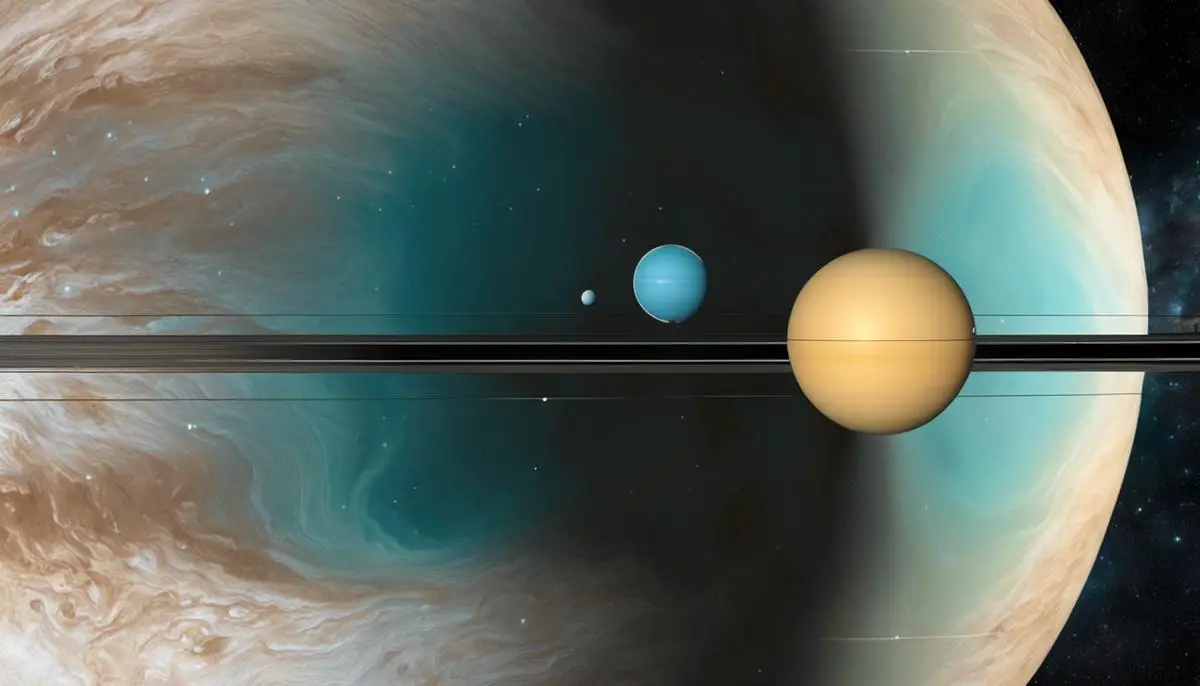In our ceaseless quest to understand the universe, each celestial entity within our reach offers a unique perspective on the planetary puzzle. Among the giants of our solar system, the ice giant Uranus, with its distinctive pale cyan hue due to methane absorption, stands as one of the most fascinating planets for study. The scope of this exploration delves into the physical dimensions of Uranus, scrutinizing its diameter, mass, and volume and how these interplay with its axial tilt and rotational dynamics. Further, a comparative size analysis sharpens our understanding of Uranus, giving it a contextual size orientation against other bodies within our solar system. Lastly, the discussions touch upon the implications of Uranus’s size on its atmosphere, magnetic field, moons, and ring system, appreciating how the magnitude of this ice giant reverberates through its unique environmental conditions and satellite systems.
Physical Dimensions of Uranus
Uranus: Size Evaluation and Unique Physical Characteristics
The seventh planet in our solar system, Uranus, stands as an exemplar of celestial wonder. Known for its distinctive cyan-blue appearance stemming from the presence of atmospheric methane, Uranus indeed piques the curiosity of astronomers and planetary scientists.
In terms of size, Uranus measures approximately 63,800 kilometers or about four times the size of Earth in terms of diameter. In fact, it is the third-largest planetary radius in the solar system and the fourth largest in terms of planetary mass.
One might deduce that the magnitude of Uranus should be merited with an equally substantial surface gravity. However, it is a fascinating revelation that Uranus’s low density results in a surface gravity slightly less than that experienced on Earth. This anomaly is attributed to the planet’s composition, which is largely gaseous with a relatively small rocky core.
Uranus’s axial tilt, another intriguing fact, is a radical divergence from other planets in the solar system. While most planetary bodies rotate on a tilt paralleling the plane of their orbit, Uranus’s axis of rotation is nearly perpendicular to this plane. As a result, its poles are almost in the plane of its orbit around the sun, experiencing 42-years long seasons of continuous daylight or darkness.
Furthermore, another manifestation of Uranus’ distinctiveness lies in its magnetosphere – far from symmetrical and remarkably tilted. Unlike most planets, where magnetic north and south align closely with the geographical poles, Uranus’ magnetic field displays a striking shift. The magnetic poles are skewed approximately 60 degrees from the planet’s axis of rotation, yielding a distinct, irregular magnetosphere.
Surrounding Uranus is a formidable system of faint rings. These rings, often perceived as black in imagery due to their low reflectivity, are not seamlessly connected but instead, composed of dispersed fragments of dark dust and ice. These rings, while not as grand or colorful as those around distant cousin Saturn, no less strike a note of fascination in the planetary scientific community.
It is also worth noting that Uranus is surrounded by an elaborate set of 27 moons, each named after characters from the works of William Shakespeare and Alexander Pope. Unlike the moons of other giant planets, these consist of roughly equal amounts of rock and ice, indicating a complex process behind their formation.
The exploration of Uranus, with its distinctive features and size, represents a substantial leap towards understanding the outer ecology of our solar system. Despite its icy distance from Earth, it remains a vibrant and vital area of ongoing investigation for planetary scientists in their pursuit of unlocking the mysteries that reside in the darkest corners of our celestial neighborhood.
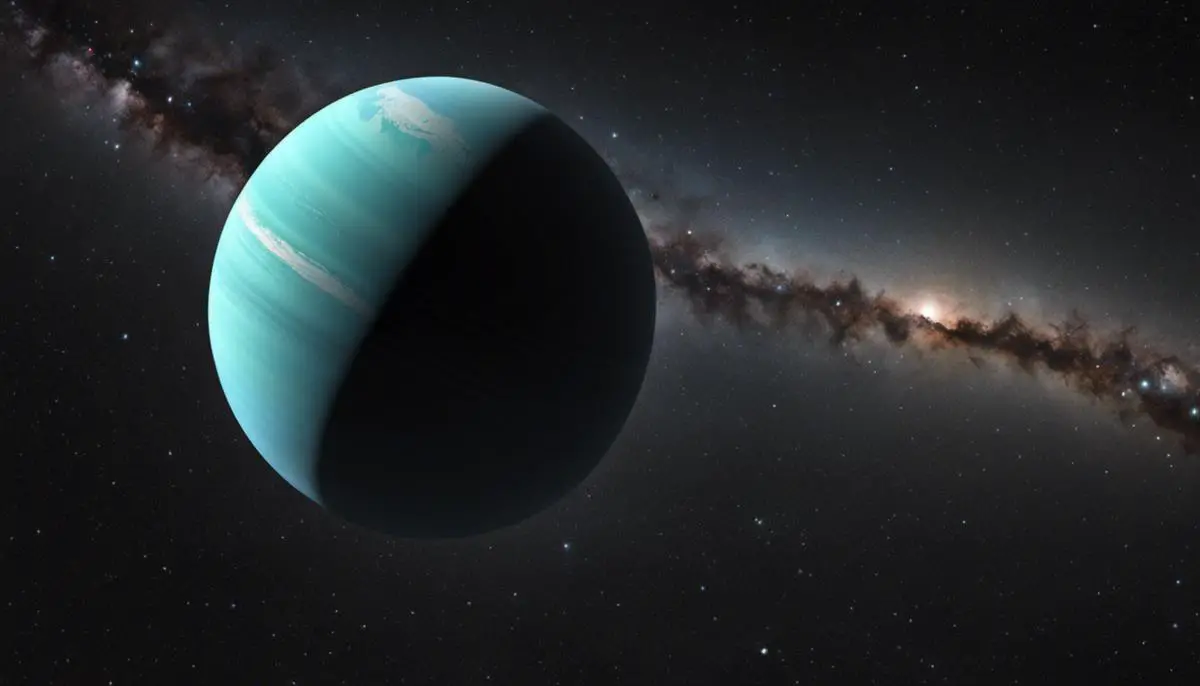
Comparative Size Analysis of Uranus
Comparative Dimensions of Uranus in Our Cosmic Neighborhood
Venturing forth into the vast interplanetary discourse, Uranus, the third largest planet in our solar system, offers an intriguing dimension of study. Despite its considerable size, the celestial giant remains relatively light in mass, largely due to the unique composition of its core.
Dimensionally speaking, Jupiter and Saturn massively overshadow this distant planet, piquing the curiosity of researchers and sparking a passionate exploration into the intricacies of our celestial neighborhood. In direct comparison, Uranus, with a diameter of approximately 31,763 miles (51,118 kilometers), is about four times the size of Earth. To illustrate this more compactly, nearly 63 Earths, lined side-by-side, could span across the equatorial plane of Uranus.
Yet, an integral part of the discourse on Uranus cannot exclude its relatively low density. Despite its voluminous physique, the planet settles in at approximately 1.27 grams per cubic centimeter. As a result, the overall mass of Uranus is significantly less, ranking it as only the fourth most massive planet in our solar system. Considering a quick comparison with our home planet, Earth’s mass stands at a hefty 5.97 x10^24 kilograms, whereas Uranus houses a mass of 8.68 x10^25 kilograms.
Candy coating the scientific discourse around the size of Uranus, it becomes compelling to take an intergalactic expedition into the gas giant’s signature “icy” composition. This ethereal profile, which contributes to Uranus’ lower mass, primarily consists of heavier volatile substances such as water, ammonia, and methane ice crystals, tucked away beneath a superficially gaseous atmosphere.
The size dynamics of Uranus presents an interesting contrast when juxtaposed with dwarf planets, particularly Pluto, the erstwhile ninth planet of our solar system. Pluto, with a diameter of roughly 1,473 miles (2,370 kilometers), is about 21.5 times smaller than Uranus. This difference elevates the interest of cosmologists and physicists alike, who seek to deepen their understanding of the unfolding physics that govern the universe’s guided chaos.
Diving into the satin-like ensemble of moons circling Uranus, these natural satellites largely follow in attendance with the size ratio of Uranus and Earth. Oberon and Titania, the two largest moons of Uranus, possess diameters of approximately 1,523 kilometers and 1,578 kilometers respectively. In this aspect, they could be compared to smaller scale versions of our Moon, which holds a diameter of roughly 3,474 kilometers.
In sum, the monumental stature of Uranus in our celestial panorama is not merely contributing to the stellar visuals that astronomy offers. The uniqueness in its substantiality cultivates an intriguing dissection of its structural and compositional characteristics, which inevitably fill in the blanks of our ever-evolving understanding of our Solar System and beyond. Even as the dialogue of comparative sizing continues, each revelation we uncover brings us closer to grasping the magnitude of mysteries the universe slyly conceals, only to unveil to those willing to traverse the depths of cosmic curiosity.
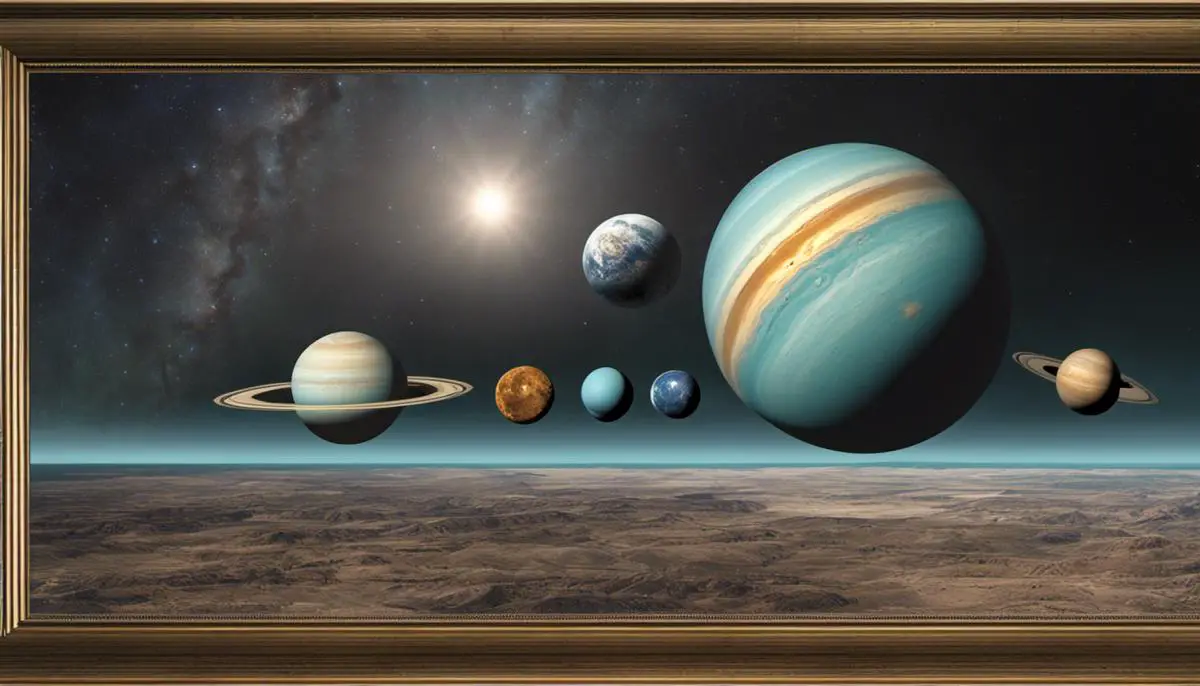
Implications of Uranus’s Size on its Atmosphere and Magnetic Field
Understanding the Size of Uranus: Implications for its Atmosphere and Magnetic Field
Scientific interest in Uranus’ mass is particularly notable due to its significant implications for both the planet’s atmosphere and magnetic field. To comprehend the profound impact of Uranus’ size, one must first consider the notable mass of the planet. Tipped the scales at approximately 14.5 Earth masses, Uranus is significantly larger than our home planet. Notably, however, it is dwarfed by gas giants Jupiter and Saturn, embodying just 4% and 5% of their masses, respectively.
Uranus’ large size directly implicates the composition and structure of its atmosphere, defining it as a distinctly “icy” giant differing from the “gas” giants within our solar system. The atmosphere of Uranus is primarily composed of hydrogen and helium, with a small but significant contribution from ‘ices’ – substances such as water, ammonia, and methane that can take solid form in the extreme cold of the outer solar system. The mean molecular weight of Uranus’ atmosphere is higher than that of Saturn or Jupiter, contributing to this icy classification and reflecting the profound impact of its size and mass.
Uranus’ substantial size also plays a significant role in the distinct characteristics of its magnetic field. Despite its misalignment and irregularity – a unique aspect of Uranus’ magnetosphere that was mentioned earlier – the magnetic field strength is roughly equivalent to that of Earth’s. This can be largely attributed to the planet’s size and inner structure. Current hypotheses propose that the unusual magnetic field is generated within a molecular hydrogen ocean on Uranus, driven by the planet’s rotation.
The intricacies of Uranus – its rings, moons, and magnetosphere – have been undoubtedly intriguing to the scientific community. This incentive is only multiplied when examining the size of Uranus, a determinant of several features and phenomena that occur within and around the planet. The mass comparison between Uranus and the largest planets – Jupiter and Saturn – alongside Earth and other dwarf planets like Pluto, emphasizes the uniqueness of Uranus’ position among celestial objects.
An examination of Uranus’ moons further underscores how the planet’s size has consequences beyond its own atmosphere and magnetic behavior. Among the 27 known satellites, the five major moons – Miranda, Ariel, Umbriel, Titania, and Oberon – are particularly intriguing. Despite being significantly smaller than Earth’s moon, these satellites exhibit a rich diversity of terrains and preside within the planet’s magnetosphere, potentially impacting their geological development in ways still to be deciphered.
In a broader sense, appreciating the large scale of Uranus, and understanding the unique characteristics this size imparts, both prove critical to broaden human understanding of our solar system and beyond. Further research and exploratory missions to Uranus, an icy ginat in our celestial backyard, will continue to refine, and possibly even redefine, our understanding of planetary science.
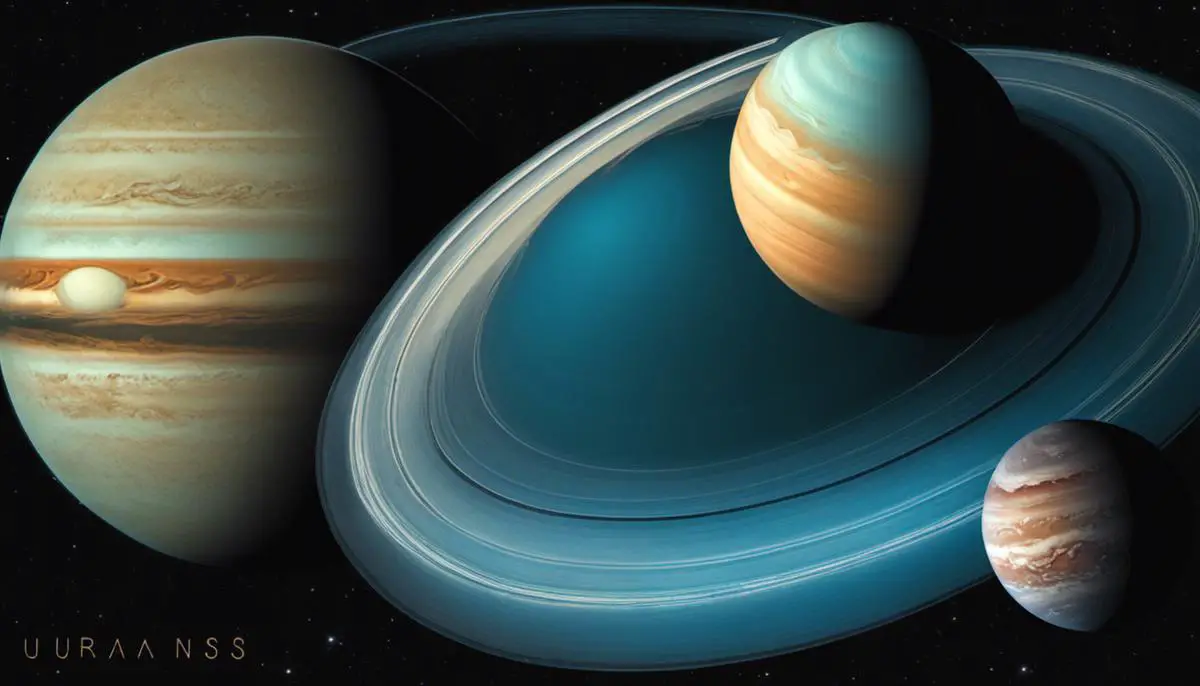
Influence of Uranus’s Size on its Moons and Ring System
Turning our discerning gaze to the fascinating subject of Uranus’s size, one cannot forgo delving into its palpable influence on the formation and properties of its moons and ring system. The celestial intricacies unravel upon a scientific understanding of the dynamics between Uranus’s size and its planetary constitution.
Predominantly composed of various ices such as water, ammonia, and methane, the large mass of Uranus, nearly 14.5 times that of Earth, exerts a significant gravitational force. This large gravitational pull has a pronounced impact on the formation and stability of its moons and rings. The 27 known moons revolving around this intriguing planet are primarily composed of a mixture of rock and ice, seemingly held together by the gravitation of Uranus.
Unraveling the role of Uranus’ size in the formation of its rings system provides an engaging discourse. Notably less dense and more varied in structure than the iconic rings of Saturn, they are made up of tremendously small, dark particles spanning up to 20 meters in diameter. The grandeur of Uranus’ size encourages the consolidation of such particles, forming thirteen distinct rings encircling the planet.
The formation and properties of Uranus’ moons are significantly influenced by the planet’s immense size. The size and gravitational pull of Uranus play indispensable roles in determining the orbital paths of these moons, resulting in remarkably regular, nearly circular orbits.
Interestingly, the outermost moons of Uranus seem to follow chaotic paths, distinctly different from the inner moons. This phenomenon, intriguingly unorthodox within the context of our solar system, may be attributed significantly to variations in the gravitational influence of the massive Uranus. The monumental size of Uranus, coupled with its relatively massive distance from the sun, might also explain the oddly retrograde and irregular orbits of some of Uranus’ outer moons.
Additionally, the impact of Uranus’s size heavily dictates the geological activity on its moons. Miranda, one of Uranus’ largest moons, showcases a dramatic example of this influence. Severe geological upheavals appear to be prompted by Uranus’s immense gravitational force, causing the moon’s icy surface to fracture into peculiar patterns.
The in-depth exploration of this intriguing celestial giant, with its unique moons and ring system, illuminates our understanding of planetary dynamics. The detailed scientific examination of these inter-relationships indeed propels the horizons of astronomy and planetary science. The key to widening our perspectives on these cosmic phenomena lies in unwavering scientific curiosity, rigor, and an unquenchable thirst for knowledge.
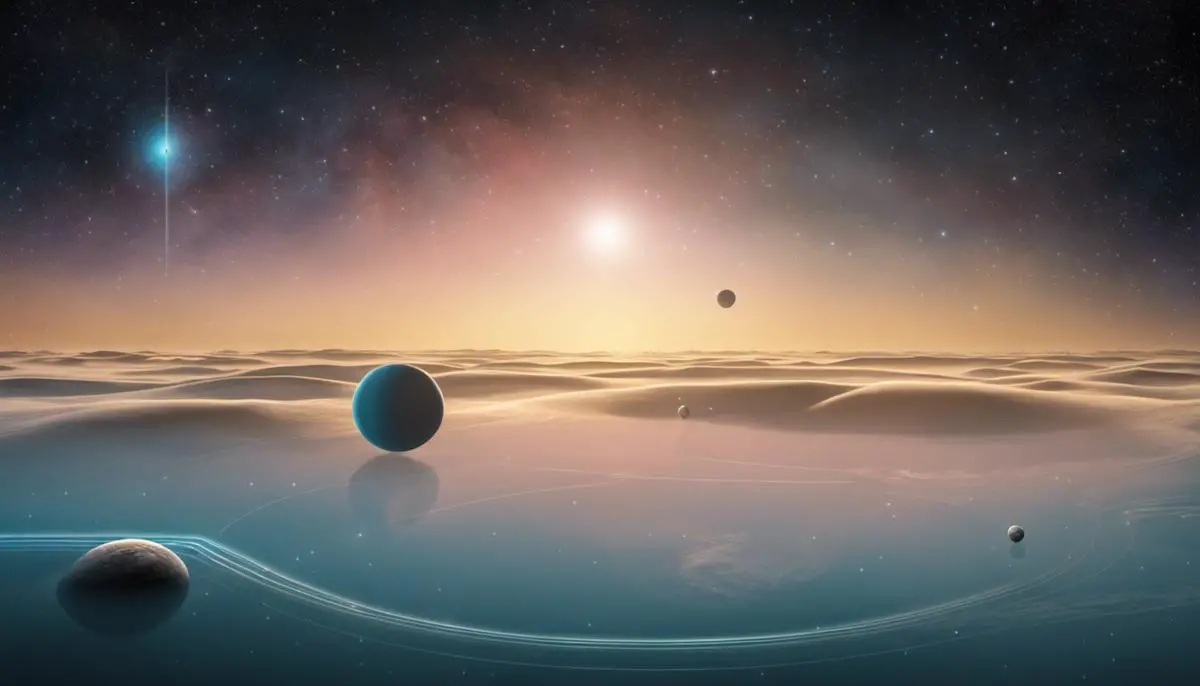
Our exploration of Uranus’s size and its broad-spectrum implications finds its culmination here, but the voyage, in reality, is perpetual. The physical dimensions, comparative analysis, and the influence of Uranus’s size on its atmosphere, magnetic field, moons, and ring system provide profound insights, interweaving a multi-layered understanding of this formidable ice giant. Such an analysis prompts us to respect the intricate planetary mechanics and marvel at the exquisite celestial ballet. Uranus, with its immense size and resulting impacts on its environment, serves as a compelling case study in our continued efforts to decipher the universe, the endless cosmos that remain filled with surprisingly elegant enigmas yet to captivate our collective curiosity.
![]()
